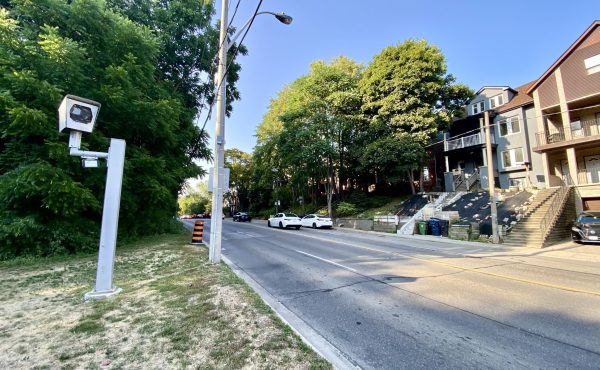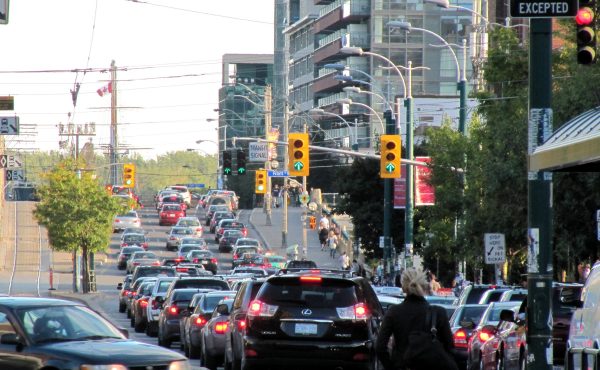
The Star Ferry passes in front of Hong Kong’s electric skyline
Hong Kong is a ceaselessly amazing case study in crowd management. With space at an absolute premium, central parts of the city have relegated the pedestrian environment upwards, in an effort to meet the needs of both pedestrians and the buses and taxis that monopolize the city’s roads. Pedestrian infrastructure here is a futuristic monument to efficiency.
While pedestrian overpasses are common throughout the city, the centrepiece of the system is found in the area simply referred to as “Central.” Here, the Hong Kong government has mandated new buildings be connected to the overpass system and throughout much of the central business district pedestrians come into little contact with the ground. It is Toronto’s PATH system realized in a warm climate. As with the PATH, some buildings are better at accommodating the pedestrian flow than others, and signage can be patchy. You can really only properly negotiate the system when you learn to stop looking for signs and just go with flow.
The most impressive part of the system, however, is clearly the Central-Mid-Levels Escalator. With claims at being the world’s longest escalator (at 800m in distance and 153m in overall vertical rise) the system is like a human-scale Gardiner Expressway. Opened in 1996, it takes riders from the heart of the business district into the dense residential areas on the slope above. Carrying an estimated 55,000 people every day, the escalator is well signed and features platforms at road crossings where pedestrians can enter or exit the system. It is impossible not to associate these areas with highway interchanges.

The Central-Mid-Levels Escalator travels over the gentrified Soho district

At a break inside the system where one can descend to street level; the escalator travels downwards for a brief period during the morning rush
The areas around of the escalator system have gentrified due to the large amounts human traffic. This area has become known as Soho and is now frequented by ex-pats and populated with trendy restaurants, shops, and bars. The escalator has had such a large impact on the neighbourhood that there are concerns that plans for additional systems will destroy traditional neighbourhoods elsewhere in Hong Kong. Planners have also become concerned that a focus on overhead systems in the city ignores the fundamental importance of a pedestrian’s interaction with the urban fabric. The Hong Kong Association of Planners cautioned the government about its over-emphasis on elevating pedestrian traffic and ignorance toward the vitality of the street below.

Significant pedestrian infrastructure above is met with an unfriendly environment below
That said, the elevated system is mostly confined to the central business area, and Hong Kong contains no shortage of incredibly lively streets and markets. In traditional neighbourhoods, markets crowd onto the streets that then become impromptu pedestrian areas. Heavy automobile taxes limit personal vehicles to the very wealthy, so that side streets have very little traffic. Recently, Hong Kong has engaged in initiatives to improve the pedestrian experience including more temporary traffic closures during weekends and peak times and new streetscape to widen sidewalks and remove clutter.
Hong Kong is one of the world’s most dynamic cities, and includes glimpses into planning that show both a modernist future and a deeply traditional past.

Peak hour pedestrian closure on busy commercial streets




6 comments
I love visiting hong Kong …. I’d be careful too about relegating pedestrian traffic above the street. But when properly implemented, it can help an area immensely and add a second dimension to the street.
Transit in Hong Kong is pretty awesome too. You can use the subway, electric trams, busses, ferry all with the “octopus” debit card. The debit card even gives you a discount for the Peak Tram.
this dovetails well with parking garages that have restaurants stores and apartments above street level.
it is only a matter of time before we can conceive of building and mapping significant routes that overlap.
and what a great reason to buy a new GPS that encorporates altitude.
I am excited!
Not too many of Spacing readers know that Hong Kong government is facing major backlash in infrastructure investment. The situation there is complete opposite of Toronto. While Toronto is fighting tooth and nail for development money from the province and the fed, Hong Kong youths (the so called ‘Post-80s’, youths who were born after 1980) are fighting against the high speed rail development.
Read about it here: http://en.wikipedia.org/wiki/Opposition_to_the_Guangzhou-Hong_Kong_Express_Rail_Link
In Hong Kong they are opposing high-speed rail for political reasons, not because they are anti-infrastructure. Cities will have to be torn down to implement the high-speed rail line and there will also be serious environmental implications. It is by no means because they do not believe in proper transit development.
In Edinburgh’s medieval part of town, three and four hundred year old bridges overlap other streets, with pedestrians and cars moving on different levels. You can see the subtle markings on maps where streets seem to intersect yet don’t.
http://bit.ly/avQqs6